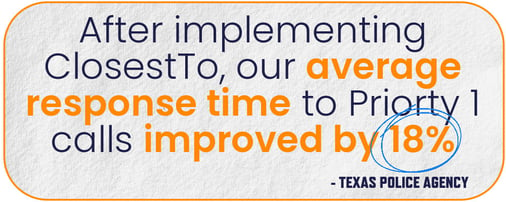 When it comes to emergencies, every second counts. Whether it’s a 911 call about a house fire, a burglary in progress, or a medical emergency, a swift response is of the utmost importance. The moment a call-for-service is placed, a race against time begins.
When it comes to emergencies, every second counts. Whether it’s a 911 call about a house fire, a burglary in progress, or a medical emergency, a swift response is of the utmost importance. The moment a call-for-service is placed, a race against time begins.
Response times vary significantly from city to city, with most cities aiming for 5 minutes or less for Priority 1 (P1) calls. Unfortunately, it can be difficult for agencies to keep response times low. In many cities across the US, response times for P1 calls are trending upwards, averaging 9.8 minutes. With an efficient Computer-Aided Dispatch (CAD) system, police, fire, and EMS departments can drastically improve their response time and, ultimately, save more lives.
By optimizing workflows, automating processes, and incorporating cutting-edge features like “ClosestTo,” Athena CAD has set a new standard for the industry. Let’s explore how it is revolutionizing emergency responses, starting with the frontrunner in reducing response times — ClosestTo.
Understanding the Power of ClosestTo
ClosestTo, a feature within Athena CAD, takes response time management to a new level. It doesn’t simply choose the nearest unit based on straight-line distance. Instead, it uses turn-by-turn GPS mapping to determine which available responder can reach the call location first.
Moreover, ClosestTo filters out units currently engaged in another call, ensuring that only available resources are considered. This highly customizable feature lets departments decide how and when it’s used. For instance, it can be set to apply solely to Priority 1 calls, such as a structure fire or an active shooter. Or, agencies can customize it to apply to only specific departments, like the fire department.
ClosestTo doesn’t just reduce response times — it amplifies the effectiveness of running orders, which are crucial for fast responses. Suppose dispatch determines the deployed unit needs backup after receiving additional details about the call-for-service. In that case, the ClosestTo algorithm will send and guide the units that can get there the fastest.
Streamlining the Call-to-Dispatch Workflow
Athena CAD software is diligently designed to streamline the call-to-dispatch workflow. It allows for immediate queuing of calls with minimal initial information, which means units can be dispatched while more details about the emergency are still being collected. The system can start the dispatch process as soon as the dispatcher begins entering the call’s basic information.
As a call comes in, the dispatcher only has to enter the call type and location before immediately dispatching. Instead of thinking or navigating through mapping and approving appropriate responders, the dispatcher can focus on getting additional information from the caller, which they add in real-time while the unit is on the way. Within milliseconds, new information appears on the officer’s mobile or tablet unit, providing crucial situational awareness to any responders.
Enhancing Situational Awareness
Situational awareness is a crucial aspect of public safety, and Athena CAD excels at providing comprehensive real-time data. Along with dispatching units, the system immediately relays essential information such as incidents, resources, water sources, schools, hazards, alerts concerning residents or neighbors, riot incidents at a location, building floor plans, utilities, and even chemical/material storage information.
As soon as units are deployed to any call-for-service, real-time alerts from both dispatch and existing situational data pop up to benefit the police officers.
Customizing the Data Set for Enhanced Efficiency
One of Athena CAD’s many strengths is its ability to be customized to suit an agency's specific needs. Every aspect of the data presentation can be tailored, from the map displays to the unique code table. This flexibility allows an agency to utilize officer safety features effectively and boost response times.
 In one instance, an agency partner of ICS noted a significant improvement in response times after implementing ClosestTo. Their average response time to Priority 1 calls improved from five minutes and forty-three seconds to four minutes and forty seconds within just a month of implementing ClosestTo. An 18% improvement in response time!
In one instance, an agency partner of ICS noted a significant improvement in response times after implementing ClosestTo. Their average response time to Priority 1 calls improved from five minutes and forty-three seconds to four minutes and forty seconds within just a month of implementing ClosestTo. An 18% improvement in response time!
ICS’s proprietary algorithms allow agencies to pre-define complex scenarios well in advance. When an emergency occurs, these pre-planned strategies and running orders can be deployed without user intervention, enabling dispatchers to handle any situation as if it were a routine call.
The Power of CAD Systems in Optimizing Emergency Responses
Just as emergencies don’t wait, neither should the response. Every second saved increases the chances of a better outcome, and implementing an efficient CAD system is a significant step toward that goal. With its innovative features like ClosestTo and a streamlined, customizable workflow, Athena CAD is changing how agencies respond to emergencies.
Due to collaborating with other Texas agencies for over 20 years, we’ve fine-tuned guiding agencies through optimizing their response time workflows. By leveraging technology in such powerful ways, Athena CAD is setting the stage for future developments in the realm of public safety.
And so, as we continue to see technological advancements in law enforcement CAD and emergency response systems, the question isn’t whether we can afford to incorporate these innovations — it’s whether we can afford not to.
Are you wondering whether or not Athena CAD could help your agency shorten response times? Reach out for a demo, and we can answer any questions you have!
/vAthena%20Logo%20-%20White.png?width=2779&height=928&name=vAthena%20Logo%20-%20White.png)
/vAthena%20Logo%20-%20Full%20Color-1.png?width=2779&height=928&name=vAthena%20Logo%20-%20Full%20Color-1.png)